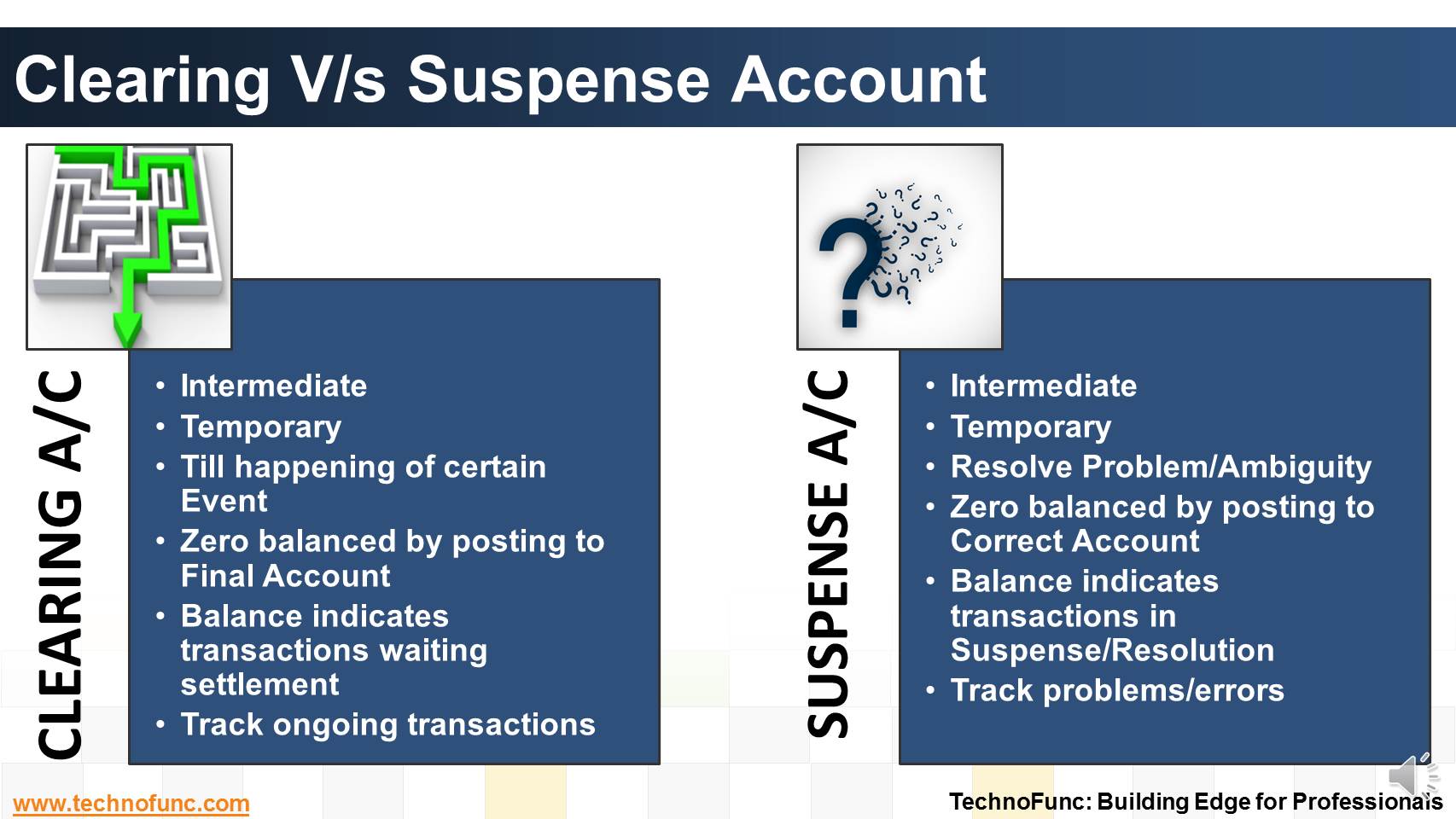- Home
- Business Processes
- Industry Knowledge
- Aerospace Industry
- Automotive Industry
- Banking Domain
- BFSI Industry
- Consumer/ FMCG Industry
- Chemicals Industry
- Engineering & Construction
- Energy Industry
- Education Domain
- Finance Domain
- Hospitality Domain
- Healthcare Industry
- Insurance Domain
- Retail Industry
- Travel and Tourism Domain
- Telecom Industry
- Leadership Skills
- eLearning
- Home
- Functional
- Cash Management
- Clearing V/s Suspense Account
Clearing V/s Suspense Account
Suspense and clearing accounts resemble each other in many respects but there exists important fundamental difference between the two. Read more to explore these differences.
Suspense and clearing accounts resemble each other in many respects but there exists one important fundamental difference.
Both are temporary accounts. Transactions are entered and finally transferred to the appropriate account.
Suspense and clearing accounts have entirely different functions.
Clearing accounts are used to hold transactions for later posting and ensure information is recorded correctly and completely.
A suspense account is used when there appears to be a problem. It serves to record an amount until the problem is resolved.
Both suspense and clearing accounts are "zeroed out" periodically. This means everything in an account is moved to other accounts, leaving a zero balance.
Suspense A/c is used for tracking Uncertainties – to hold transactions when there is some ambiguity involved.
For example, customer has deposited payment in the bank account and you are unable to identify the customer from available information,
You can put the transaction in a suspense account until you determine where it belongs.
Whereas Clearing Accounts are used for tracking transactions on a temporary basis until it's time to post them to a more permanent account.
Taking the same example, now the customer has sent payment against many outstanding invoices and you know it belongs to a particular customer but not to which invoice.
This may be parked in a clearing account until the confirmation is received from customer and amount applied to correct invoice.
Just to keep track of correct outstanding past due invoices.

Related Links
You May Also Like
-
Have you ever wondered what is actually a Bank Statement and why it is needed. What is the information that is available in a bank statement?
-
What are the various sources of cash in an organization. Which sources increase the cash available with the enterprise and which sources results in outflow of the cash? Let us explore!
-
Why enterprises need cash management. What is the purpose of having a well defined cash management process?
-
The terms Treasury Management and Cash Management are sometimes used interchangeably, while, in fact, the scope of treasury management is larger and includes funding and investment activities as well. Learn all about Treasury Management here!
-
Collection Float is the time spent to collect receivables. Collection float is the sum total of time taken by Invoice Float; Mail Float; Processing Float and Availability Float. Explore more!
-
Effectively using cash management with trade finance products brings tangible benefits to both corporates and financial institutions.Learn the various benefits of cash management process.
-
Although there is no straight forward answer to the question, how to best organize a treasury function, this article provides an generic view of the way large MNCs creates departments or sub-functions within the treasury function.
-
In automated clearing, Bank statement details are automatically matched and reconciled with system transactions. Learn how this process works and what are the perquisites to enable the same.
-
The Cash Management component ensures that the enterprise has sufficient liquidity for payments that are due and to monitor payment flows. Learn how treasury plays an important role in cash management for the enterprise.
-
Before we dive into cash management, let us fist understand what we mean by cash and what constitutes cash in context of cash management process.
Explore Our Free Training Articles or
Sign Up to Start With Our eLearning Courses

About Us
Learning
© 2023 TechnoFunc, All Rights Reserved










